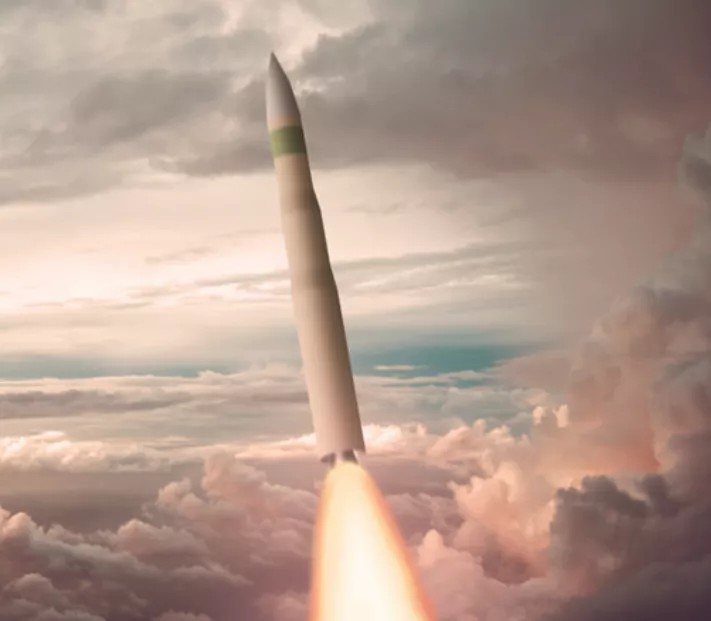
Photo:US Air Force
The replacement of the aging LGM-30G Minuteman III missile system with the Sentinel is estimated to cost $100 billion. Its deployment has been delayed to a period between April and June 2030.
Secretary of the US Air Force Frank Kendall disclosed on Monday that one of their nuclear missile initiatives - the LGM-35A Sentinel intercontinental ballistic missile - is "struggling," potentially leading to a cost surge.
Speaking at an online event hosted by the Center for a New American Security think tank, Kendall emphasized the critical importance of both the Sentinel and the B-21 Raider stealth bomber managed by Northrop Grumman.
What is LGM-35A Sentinel?
Initially named the Ground Based Strategic Deterrent (GBSD), the Sentinel project was awarded to Northrop in 2020 under a $13.3 billion contract. It aims to replace the aging LGM-30G Minuteman III missile system and involves extensive real estate, civil engineering, infrastructure, and missile production undertakings. The program is part of the US' $1.5 trillion nuclear modernization and is expected to cost $264 billion throughout its lifecycle, per sources. Sentinel is engineered with a flexible systems framework, permitting enhancements over the weapon system's operational lifespan.
Technical Specifications of the Sentinel Program
Missile type: intercontinental ballistic missile (ICBM)
Warhead weight: W87-0/Mk21 (300 kilotons of TNT) and W87-1/Mk21A thermonuclear warheads and aeroshells
Detonation mechanism: ground-burst and/or air-burst fusing modes
Guidance system: astro-inertial and GPS
Carriers: Northrop Grumman B-21 Raider stealth strategic bomber
Maximum speed: over 5,500 km/h (more than 4.6 Mach)
Launch platform: missile silos
Engine: three-stage solid-fuel rocket
LGM-35A Sentinel ICBM Setbacks
Kendall highlighted the emergence of "unknown unknowns" in the Sentinel program, especially concerning command-and-control infrastructure, which could increase costs. He noted that as the program progresses, more complexities and financial impacts are being uncovered. The Government Accountability Office (GAO) reported in June that the Sentinel's deployment is expected between April and June 2030, delayed from 2029. This postponement is attributed to ongoing staffing, supply chain, and software challenges.
In contrast, Kendall expressed cautious optimism about the B-21 Raider program, acknowledging its recent first flight on November 10, 2023, and recognizing the extensive flight testing ahead. Despite minor internal delays, the B-21 program has primarily followed the plan established by William LaPlante (as the assistant secretary of the Air Force) and Kendall (as the under secretary of defense for acquisition) during their previous Pentagon roles in the Obama administration.
Despite substantial financial resources allocated to the missile initiative, the Sentinel program's digital engineering environment (DEE) is still under development. This crucial aspect of the program's procurement plan is unfinished, creating potential delays in the Sentinel's schedule, which includes pivotal steps like the system-level critical design review and the maiden flight in fiscal year 2024, according to GAO findings.
Furthermore, as a program heavily reliant on software, it operates under a tight timeline. The extensive and intricate nature of its software development, coupled with the specific demands of nuclear deterrence, presents significant risks. The program is currently experiencing challenges in transferring data across networks with varying security levels, awaiting confirmation for its transfer mechanism from both the Air Force and the National Security Agency.
Early Testing of LGM-35A Sentinel
On March 2, 2023, the inaugural full-scale static fire test of the stage one solid rocket motor was conducted at Northrop Grumman's test site in Promontory, Utah. Major General John Newberry, commander of the Air Force Nuclear Weapons Center and program executive officer for strategic systems in the Air Force, stated to news sources that the test marks the beginning of a sequence of evaluations of the weapon system's hardware in actual conditions.
Media outlets reported that a series of wind tunnel tests had been conducted on scaled models of the LGM-35A missile. These tests, conducted over the course of a year in various locations, involved seven campaigns, each of which was designed to measure the missile's response under different atmospheric, load, and speed conditions. The tests were said to have simulated the entire range of missile operations, including launch, stage separation, and various flight maneuvers at subsonic and hypersonic speeds. A press release from Northrop Grumman, dated February 16, 2023, was cited as confirming that these physical tests had validated the program's digital models and simulations, thereby demonstrating the missile's design maturity.
